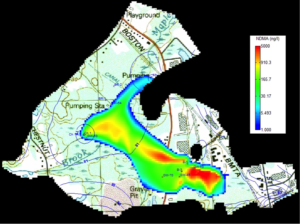Fate and Transport Modeling of Chemical Contaminants in a Public Water Distribution System

Over two decades, children living in Wilmington, MA experienced elevated rates of certain types of cancer. It has been hypothesized that exposure to N-nitrosodimethylamine (NDMA), a suspected human carcinogen, and possibly other chemicals in the town’s water supply may in part explain the high cancer rates. HydroAnalysis, working with Prof. John Durant of Tufts University, undertook a study to model the concentration histories of NDMA and other known contaminants in the Wilmington water distribution system between 1981 and 2003. Our goal was to estimate how contaminant concentrations changed as a function of time and location within the water distribution system. The project was completed for the Massachusetts Department of Public Health.
To do this we (1) reviewed documents describing pollutant sources, fate, and transport at a nearby hazardous waste site (the Olin Site) and within the Maple Meadow Brook aquifer, from which Wilmington extracted ground water, (2) analyzed historical water quality data from the Wilmington water distribution system, (3) developed a groundwater transport model to estimate travel times and concentration of pollutants in the aquifer, and (4) developed a water distribution system model to estimate pollutant levels in the water distribution network.
HydroAnalysis constructed a groundwater model to estimate NDMA travel times between the Olin Site and the Maple Meadow Brook aquifer wells that supplied the Town of Wilmington and predict contaminant concentrations at the water wells. We then used a hydraulic model of the Wilmington water distribution system to simulate the spatial distribution of contaminants within the town’s water network. The model was modified so as to represent the historical state of the system during the years 1988 to 2000. TCE and 1,2-DCE were also simulated for historical conditions extending back to 1982. The model was successful in matching the measured spatial distribution of TCE measured in July 1986.
The study was published as a conference paper: J.L. Durant, B. Jacobs, and P. Shanahan, “Historical Inputs of N-nitrosodimethylamine to the Public Drinking Water Supply in Wilmington, Massachusetts,” In: R.W. Babcock, Jr. and R. Walton, editors, Proceedings of The World Environmental & Water Resources Congress, May 12-16, 2008, Honolulu, Hawai’i. American Society of Civil Engineers, Reston, Virginia.